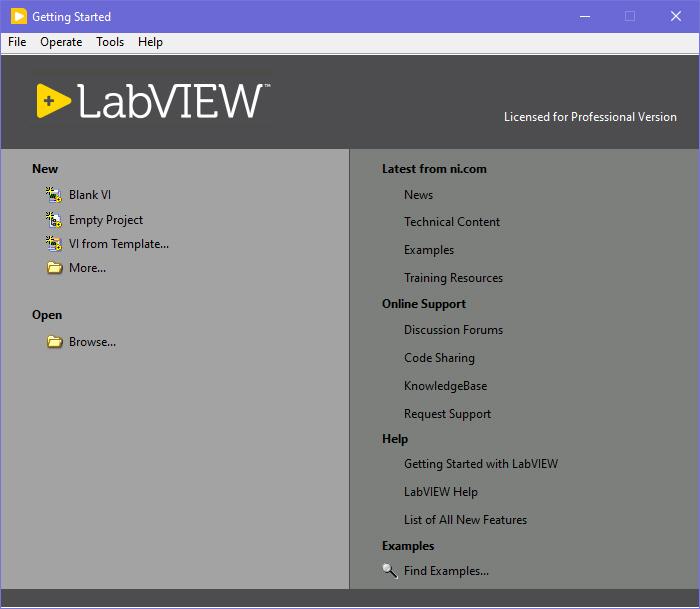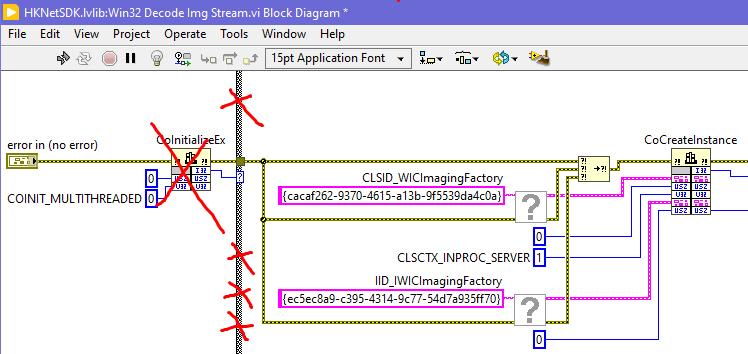-
Posts
369 -
Joined
-
Last visited
-
Days Won
41
Content Type
Profiles
Forums
Downloads
Gallery
Everything posted by dadreamer
-
Tried that. 2009 is the latest version where the GSW has not been packed yet (lvlib). I have slightly reworked that window to satisfy my preferences (dark mode etc.) and used it for 2020 and 2021 versions. But in 2022 Q3 something has changed in the underlying C code, that's supporting the behaviour of the GSW and due to that my modded GSW stopped working normally. I've applied few workarounds but still there are some quirks. Besides that '09 GSW is too ascetic, maybe I could remake it more extensively, but I decided to leave it as is.
-
I got used to almost everything in modern LabVIEW, but these two are driving me nuts. - "new styled" bright white splash screen and GSW (Getting Started Window) (since LV 2021 and up); - online help in LabVIEW 2022 Q3 (and probably up?).
-
Yes. Also stays (and works) in RTE, when the VI is compiled. Also works if saved for previous down to LV 8.0. In fact LV 8.0 didn't have that token in its exe code, but the call remained inlined. LV 8.6 had that token, so confirmed it there as well.
-
I meant these ini tokens.
-
-
Yeah, it would be nice to finally see those mysterious tokens to confirm or refute our guesses 🙂
-
Took some time to find this old thread in the Wayback Engine, but here it is: http://web.archive.org/web/20080315135806/http://forums.lavag.org/Comments-in-Configuration-Files-t9183.html&mode=linear You want the "read_configuration_data.vi ( 78.66K )" attachment.
-

LabVIEW 2021 missing from profile version selector
dadreamer replied to Sparkette's topic in Site Feedback & Support
Missing no more. -
Generally I agree with Rolf here. That ArrayMemInfo node even though looks neat and easy-to-use could easily be removed in the future versions of LabVIEW as it's for internal use only. NI has already removed many undocumented or obsoleted stuff from the core of LV 2022, including all the NXG helper functions like that NCGGetOperateDataPointer. If it goes to production, I'd prefer conventional Memory Manager functions like DSNewPtr and friends.
-

LabVIEW 2021 missing from profile version selector
dadreamer replied to Sparkette's topic in Site Feedback & Support
Selecting this context menu entry opens the browser and displays this page. No more built-in help?.. If so, I assume they didn't fill all the documents yet. -

LabVIEW 2021 missing from profile version selector
dadreamer replied to Sparkette's topic in Site Feedback & Support
2022 Q3 is already available for download from NI website. All the three OS'es are in place and the Community edition too. Not touching the subscription issues, nobody stops me from using a trial and during that time I could specify "2022" in my profile 🙂 -

LabVIEW 2021 missing from profile version selector
dadreamer replied to Sparkette's topic in Site Feedback & Support
What about 2022? I suppose expect it being out soon. I've seen some guys are using 2022 Beta meantime. -
Why do you use Read from Text File VI instead of Read from Binary File VI? Read from Text File VI does End-Of-Line chars conversion by default. It could be disabled in the RMB context menu of the node.
-

Using the DLL files of an application compiled with C# with labview
dadreamer replied to alvise's topic in LabVIEW General
Windows Imaging Component already has native bitmap decoder for BMP format, that works "out-of-box". So why reinvent all that from the scratch? Of course, there would be a reason, if we were on Linux or macOS. As it's about Windows only, then the WinAPI decoder should be already optimized to process the formats fast enough. I doubt it would be worse in performance than the LabVIEW built-in instruments. -

Using the DLL files of an application compiled with C# with labview
dadreamer replied to alvise's topic in LabVIEW General
It was a project with MOXA video server, that was digitalizing an analog video signal and outputting it each 25 to 30 frames per second. That SDK was providing only a JPEG stream, hence I had to use some helper decoder of mine. Later we switched to another video server, that was able to output in many other formats besides, including a RTSP one. There exists one more way to make the CLFNs run in the same thread and stay in 'any thread' all the time. I recall that I was having some thread unsafe DLL, that I wanted to use in my project, but I absolutely didn't want it to run in UI thread. Then I used Timed Loop for that and it worked like a charm. But I have never dug those built-in XNodes deep enough to see, how they work internally. -

Using the DLL files of an application compiled with C# with labview
dadreamer replied to alvise's topic in LabVIEW General
Remove this and try again. I think, if your memory stays on nearly the same level (say, 180 MB) for a few hours and does not jump high drastically, then no need to worry. -

Using the DLL files of an application compiled with C# with labview
dadreamer replied to alvise's topic in LabVIEW General
For this you would need to: - change the type of the user event in two locations: on the diagram and in the callback code; - slightly change the callback logic, trying some things: first try to post the cluster with the data handle address instead of the array, second try to not allocate the array and copy the data into it, but post the original SDK pointer to LV directly. Plus in fact we even don't decode the data ourselves - the PlayM4 decoder does it for us! As we need the data type mostly and don't need the actual data contents, we could ease the callback logic a little. But I neither want to say you to do this right now, nor I'm inclined to do this myself. I think Rolf is going to come with more advanced diagnostics or solutions. -

Using the DLL files of an application compiled with C# with labview
dadreamer replied to alvise's topic in LabVIEW General
Actually I would try to eliminate one handle allocation by passing a pointer with PostLVUserEvent and dereferencing it in LabVIEW (+ deallocate it manually, of course) (as I already mentioned on the first pages of this thread). It would be more of a test to see if the large memory consumption goes away. If not, then it's reasonable to allocate the space just one time (when the DLL is loaded, for example, or right on the diagram with DSNewPtr) and free it when the app ends (when the DLL is unloaded or with DSDisposePtr on the diagram). -

Using the DLL files of an application compiled with C# with labview
dadreamer replied to alvise's topic in LabVIEW General
Win32 Decode Img Stream.vi does not produce memory leaks of any sort. I've been running it on a production for months. Never ever received errors from that VI. As to CoInitializeEx, it was implemented this way in the original thread on SO, I just borrowed the solution. But I checked now, CoInitializeEx always returns TRUE, no matter what. Extra resources are not allocated. I assume it's safe enough to call it multiple times from the same thread. But you may easily add CoUninitialize to there, if you're afraid it works improperly. I'm just thinking this might be not a good idea, given that description of the function: A lot of work would be done on each call. Better to do this once on the app exit. Or leave it to the OS, when LabVIEW quits. -

Using the DLL files of an application compiled with C# with labview
dadreamer replied to alvise's topic in LabVIEW General
Does it get to 1GB after running for 1 hour? -

Using the DLL files of an application compiled with C# with labview
dadreamer replied to alvise's topic in LabVIEW General
You may relatively easy check this. Make a test VI and remove there everything related to the PlayM4 decoder and the image conversion. Leave the User Event completely empty. Get the memory space measurements during the run of that VI. -

Using the DLL files of an application compiled with C# with labview
dadreamer replied to alvise's topic in LabVIEW General
Yeah, something is not freed properly and eating your resources. You need to find what it is. -

Using the DLL files of an application compiled with C# with labview
dadreamer replied to alvise's topic in LabVIEW General
I'm afraid you need to check and test everything. By the way. Do you see a memory leak in Windows Task Manager when running the app for a long time? Compare the occupied memory space, when you've just started the stream, with that one after a hour. You mean GetJPEG returning 0? If that occurs on the recent version of your VI, then it might be that when the image is very large, it takes too much time to process the data, and your LV User Event doesn't have a chance to handle it all in time. You need to view the Event Inspector and watch the amount of events in there. -

Using the DLL files of an application compiled with C# with labview
dadreamer replied to alvise's topic in LabVIEW General
Very hard to tell. You need to check the functions return values one by one, and not only in LabVIEW, but in the DLL as well. Use DbgPrintf window to ease the debugging. To me it seems more like a call sequence mistake of some sort. But it may be resource leaking too, as if for example you'd forget to close some handle or free some pointer. -

Using the DLL files of an application compiled with C# with labview
dadreamer replied to alvise's topic in LabVIEW General
Better now. I would move that Stop, CloseStream and FreePort stuff to the main loop (to "stop" frame), but it's your decision.







